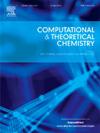Computational investigation of tetraamine–derived Schiff base ligands and their Cu(II) and Zn(II) complexes
IF 3
3区 化学
Q3 CHEMISTRY, PHYSICAL
引用次数: 0
Abstract
The theoretical quantum chemical methods were employed to design tetraamine–based Schiff bases and investigate their interaction with Cu2+ and Zn2+ ions. Three ligands were designed from the possible condensation product of [1,1′–biphenyl]–3,4,3′,4′–tetraamine with thiophene–2–carbaldehyde (L1), 2–furaldehyde (L2), and 1H–indole–3–carbaldehyde (L3). The geometric optimizations, in conjunction with interaction analyses, elucidated the pronounced binding affinity of the ligands for metal ions, with Cu(II) complexes displaying a significantly greater affinity in comparison to their Zn(II) analogs. Molecular orbital evaluations suggested robust metal–ligand interactions, whereby Cu(II) complexes demonstrated enhanced stability in contrast to Zn(II) complexes, which indicated increased reactivity, thereby implying a potential for augmented biological efficacy. Electrostatic potential (ESP) mapping further corroborated the binding affinities of the complexes by illustrating the regions of electrostatic interactions. Furthermore, non-covalent interaction (NCI) analysis provided comprehensive insights into the nature and strength of the forces governing metal–ligand binding, revealing that the stronger interactions in Cu(II) complexes account for their enhanced stability. These theoretical insights provide significant direction for prospective experimental investigations of Schiff base metal complexes in the realms of biomedical and catalytic applications.

四胺衍生席夫碱配体及其Cu(II)和Zn(II)配合物的计算研究
采用理论量子化学方法设计了四胺基席夫碱,并研究了它们与Cu2+和Zn2+离子的相互作用。从[1,1 ' -联苯]- 3,4,3 ',4 ' -四胺与噻吩- 2 -甲醛(L1), 2 -呋喃醛(L2)和1h -吲哚-3 -甲醛(L3)的可能缩合产物设计了三个配体。几何优化,结合相互作用分析,阐明了配体对金属离子的明显结合亲和力,与Zn(II)类似物相比,Cu(II)配合物显示出更大的亲和力。分子轨道评价表明金属-配体相互作用强劲,其中Cu(II)配合物比Zn(II)配合物表现出更强的稳定性,表明反应性增强,从而暗示有可能增强生物功效。静电电位(ESP)作图进一步证实了配合物的结合亲和力,说明了静电相互作用的区域。此外,非共价相互作用(NCI)分析提供了对控制金属配体结合力的性质和强度的全面见解,揭示了Cu(II)配合物中更强的相互作用是其稳定性增强的原因。这些理论见解为希夫贱金属配合物在生物医学和催化应用领域的前瞻性实验研究提供了重要的方向。
本文章由计算机程序翻译,如有差异,请以英文原文为准。
求助全文
约1分钟内获得全文
求助全文
来源期刊

Computational and Theoretical Chemistry
CHEMISTRY, PHYSICAL-
CiteScore
4.20
自引率
10.70%
发文量
331
审稿时长
31 days
期刊介绍:
Computational and Theoretical Chemistry publishes high quality, original reports of significance in computational and theoretical chemistry including those that deal with problems of structure, properties, energetics, weak interactions, reaction mechanisms, catalysis, and reaction rates involving atoms, molecules, clusters, surfaces, and bulk matter.
 求助内容:
求助内容: 应助结果提醒方式:
应助结果提醒方式:


